We're still writing, but we've moved to a new space. To keep reading, click here.
Thanks!
Kathryn Juergens, sales and marketing associate
Tuesday, September 22, 2009
Wednesday, September 16, 2009
Black Plants bloom day!
I'm a relative newcomer to the world of garden blogging, and I sometimes come across blog topics that are a whole new world of gardening that I never thought of. The concept of "bloom day" was just such a topic. "What's this 'bloom day'?" I thought to myself. "It looks like pictures of people's flowers. Surely it can't be that simple? There must be some larger purpose."
After much curious browsing of the internet, I think I've discovered three things.
1) There is no larger purpose that I can see - and really, it doesn't matter.
2) Flowers are pretty.
3) Bloom Day appears to occur between the 14th and the 16th of every month. Ideally the 15th, but you know - some people get excited, and some people get late.
So, in honor of Bloom Day, finding useful information on the internet, and the release of our new book on black plants, I am posting some images of black flowers. I believe that technically, these flowers should be growing in my own garden, so I've picked ones that I would like to have in my garden, given half a chance. I am also posting a day late - but I'm hoping that no-one will refuse to look at flowers just because they are posted on the 16th instead of the 15th.
Aeonium zwartkop - Not technically a flower (I'm breaking all the Bloom Day rules in my first post)but look how incredible it looks. If this were in my garden, I would wear striped Dr. Seuss socks every single day in honor of my aeonium.

Helleborus Winter Jewels Black Diamond - I think the green and black combination would make for a really interesting shady spot.

Viola Sorbet - So velvety. Like sorbet. Blackberry sorbet.

Alcea nigra - I love the drops of water on the petals.

Chani West-Foyle, Marketing Associate
After much curious browsing of the internet, I think I've discovered three things.
1) There is no larger purpose that I can see - and really, it doesn't matter.
2) Flowers are pretty.
3) Bloom Day appears to occur between the 14th and the 16th of every month. Ideally the 15th, but you know - some people get excited, and some people get late.
So, in honor of Bloom Day, finding useful information on the internet, and the release of our new book on black plants, I am posting some images of black flowers. I believe that technically, these flowers should be growing in my own garden, so I've picked ones that I would like to have in my garden, given half a chance. I am also posting a day late - but I'm hoping that no-one will refuse to look at flowers just because they are posted on the 16th instead of the 15th.
Aeonium zwartkop - Not technically a flower (I'm breaking all the Bloom Day rules in my first post)but look how incredible it looks. If this were in my garden, I would wear striped Dr. Seuss socks every single day in honor of my aeonium.

Helleborus Winter Jewels Black Diamond - I think the green and black combination would make for a really interesting shady spot.

Viola Sorbet - So velvety. Like sorbet. Blackberry sorbet.

Alcea nigra - I love the drops of water on the petals.

Chani West-Foyle, Marketing Associate
Labels:
Color Bloom_Day Flowers
Tuesday, September 15, 2009
Raleigh, Here We Come

In the grand scheme of things, four business trips a year doesn’t seem like much. But for me, four trips feels like a lot. I’ve been to Seattle for the Northwest Flower Show. I’ve been to New York twice--once for Book Expo America, and again last month for pitching New York media. Next week, I’m headed to the most anticipated event in the garden media world--the annual Garden Writers Symposium, this year held in Raleigh (September 23-26).
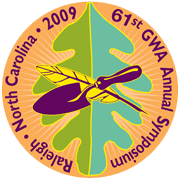
If you’ve never been to the Symposium, you’re probably wondering what it’s all about. Typically, the show has a two day exhibit, lots of seminars, fabulous garden tours, and an awards banquet. This year is no different, but there are a couple of differences for me in my third year of attendance. First, Timber is sharing a booth with our sister company Storey Publishing for the first time. Normally we have a double booth, but this year we decided to economize. It’s going to be lots of fun--kind of like trying to see how many people can fit into the same shirt all together. We’ll certainly be cozy!
The second difference is that I’m going to be on one of the seminar panels. This is a huge leap for me as I haven’t addressed a crowd larger than ten since my high school graduation speech. And here I’ll be, with three of my peers, talking about what it’s like to publicize a book at Timber. Sound straightforward? Well, technically yes, but I’m still wondering exactly what I’m going to say. It may just come down to the wire on this one.
Garden Writers is a great opportunity to get together with old friends, meet new ones, swap stories, and just have a grand old time. If you’re going to be at the Symposium, please stop by the Timber Press/Storey Publishing booth, #509. We’ll have lots of books, materials, and business cards to give away!
Olivia Dunn, publicity
Friday, September 11, 2009
Eight-byte Epiphytes
As the Timber Press Web and IT Manager, I'm probably one of the nerdier people in the office.
Well, I should probably qualify that, given that from my desk I can see coworkers who are probably thinking right now about graphic novels and/or Star Wars (don't worry, office-mates, I will keep your identities safe from the Internet ... for now). To say nothing of the discussions I've had with members of the editorial department on the finer points of grammar.
Fine, I'm one of many nerdy people in this office. But I'm the only one I know of to have taken an interest in a particular old book I found one day while perusing the extensive backlist in our library. That book is Computer Graphics in Biology, and this is the story of my adventure with that book.

No, wait, don't stop reading yet! I appreciate that it takes a certain kind of nerd to be interested in a computer book published in 1986, and I further appreciate that you might not be that kind of nerd. After all, there's probably a reason we didn't go on to publish a whole lot more books on the intersection of computer graphics and biology -- say, AutoCAD and The Arborist: a Guide to Plotting the Perfect Pruning, or perhaps Variegated Virtual Reality: Why All Gardens in the Future Will Require a Different Kind of Glove.
Technically, Timber Press didn't publish Computer Graphics in Biology, either. That credit goes to our erstwhile imprint, Dioscorides Press. It was part of a series titled Advances in Plant Sciences, though subsequent volumes (including Adventitious Root Formation in Cuttings and Isozymes in Plant Biology) were decidedly more for nerds of a greener stripe.
I'd like to tell you more about the book, but frankly, it's a bit of a slog to get through, unless you happen to like plants (check), computers (check), and possess a technological masochism that precludes you from enjoying the advances made in computing since 1986 (sorry, but here I must draw the line).
I did, however, make it far enough through the preface to find a reference to "the recent upsurge in graphical man-machine interfaces, notably the WIMP (window, icon, mouse, pointer) system seen on the Apple Mackintosh [sic] and Commodore Amiga computers". Oddly, though such things are in fact quite popular today, I can't say the same for the "WIMP" acronym. Not sure why that didn't catch on.
Anyhow, both computer graphics and Timber Press have moved on, and I'm happy to report that there's not a lot of discussion of Fortran in the office these days. But don't let that stop you from submitting your proposal for Eight-byte epiphytes -- I can promise that, if no one else will, I'll at least give it a once-over. But, sorry, we can't accept submissions on 5.25" disks anymore.
Well, I should probably qualify that, given that from my desk I can see coworkers who are probably thinking right now about graphic novels and/or Star Wars (don't worry, office-mates, I will keep your identities safe from the Internet ... for now). To say nothing of the discussions I've had with members of the editorial department on the finer points of grammar.
Fine, I'm one of many nerdy people in this office. But I'm the only one I know of to have taken an interest in a particular old book I found one day while perusing the extensive backlist in our library. That book is Computer Graphics in Biology, and this is the story of my adventure with that book.

No, wait, don't stop reading yet! I appreciate that it takes a certain kind of nerd to be interested in a computer book published in 1986, and I further appreciate that you might not be that kind of nerd. After all, there's probably a reason we didn't go on to publish a whole lot more books on the intersection of computer graphics and biology -- say, AutoCAD and The Arborist: a Guide to Plotting the Perfect Pruning, or perhaps Variegated Virtual Reality: Why All Gardens in the Future Will Require a Different Kind of Glove.
Technically, Timber Press didn't publish Computer Graphics in Biology, either. That credit goes to our erstwhile imprint, Dioscorides Press. It was part of a series titled Advances in Plant Sciences, though subsequent volumes (including Adventitious Root Formation in Cuttings and Isozymes in Plant Biology) were decidedly more for nerds of a greener stripe.
I'd like to tell you more about the book, but frankly, it's a bit of a slog to get through, unless you happen to like plants (check), computers (check), and possess a technological masochism that precludes you from enjoying the advances made in computing since 1986 (sorry, but here I must draw the line).
I did, however, make it far enough through the preface to find a reference to "the recent upsurge in graphical man-machine interfaces, notably the WIMP (window, icon, mouse, pointer) system seen on the Apple Mackintosh [sic] and Commodore Amiga computers". Oddly, though such things are in fact quite popular today, I can't say the same for the "WIMP" acronym. Not sure why that didn't catch on.
Anyhow, both computer graphics and Timber Press have moved on, and I'm happy to report that there's not a lot of discussion of Fortran in the office these days. But don't let that stop you from submitting your proposal for Eight-byte epiphytes -- I can promise that, if no one else will, I'll at least give it a once-over. But, sorry, we can't accept submissions on 5.25" disks anymore.
Labels:
Publishing
Thursday, September 10, 2009
Green bean takeover
Only a few short weeks ago I was complaining that my scarlet runner beans were not providing me with the green beany-ness that I was expecting. They had lovely red flowers, and the hummingbirds seemed to like them, but where were the beans? Nowhere. How was I going to practice making pickled green beans if I had no beans to pickle?
My green bean plant rose to the occasion. First, it assumed an intimidating Godzilla-like shape and loomed over my carrots.

(I am trying not to be alarmed that it is headed for the general direction of my house.)
Then, overnight, it produced a huge abundance of green, green beans.

I made a lovely green bean, corn, and ricotta salad with the first batch, and am dreaming of rows of pretty pickles.
Chani West-Foyle, Marketing Associate
My green bean plant rose to the occasion. First, it assumed an intimidating Godzilla-like shape and loomed over my carrots.
(I am trying not to be alarmed that it is headed for the general direction of my house.)
Then, overnight, it produced a huge abundance of green, green beans.
I made a lovely green bean, corn, and ricotta salad with the first batch, and am dreaming of rows of pretty pickles.
Chani West-Foyle, Marketing Associate
Tuesday, September 8, 2009
Book Burning and Book Beaching
There are few things in life to which I am willing to attach the phrase, “It will change your life!” Hence the reason that I will never make a living selling cars. Or shoes. Or face cream. But ... I cannot say the same about books. They are life-changing.
A book can change the course of the future. A book can cause a society to see things differently, get riled up, burn things. For example, here is a small list of books that have been banned by certain societies:
Alice’s Adventures in Wonderland by Lewis Carroll was banned in China for the portrayal of animals acting as humans, Animal Farm by George Orwell was banned for political reasons.
As I Lay Dying by William Faulkner was banned in Kentucky for language and for being anti-Christian.
The Catcher in the Rye by J.D. Salinger was banned in the US and Australia.
The Grapes of Wrath by John Steinbeck was banned in many parts of the US, especially California, because it made the residents of the region look bad.
Lolita by Vladimir Nabokov was banned for obscenity in France, the UK, Argentina, New Zealand, and South Africa.
Mein Kampf by Adolf Hitler was banned because of anti-Nazi laws and for being extremist.
Because books are so wonderful, important, and controversial, I feel 100% great telling everyone about the Sylvia Beach Hotel. I had the immense pleasure of staying there with my sister a few weekends ago, and it was perfect.

Located on a lovely ridge overlooking Nye Beach, Oregon, the Sylvia Beach Hotel is made for people who want to relax on a soft couch on Friday night, drinking mulled wine in lovely silence with a favorite book. There are no TVs or radios or phones or internet access. Instead, there is an enormous library/lounge filled with blankets and pillows and couches and journals for guests to write in. Each room is decorated in honor of a famous author: Mark Twain, Ernest Hemingway, Virginia Woolf, J.R.R. Tolkien, Dr. Seuss, and many more.

My sister and I stayed in the Oscar Wilde room. Black and white photos of the author lined the walls, there was a tiny Victorian writing desk in the corner, and the wallpaper was hideously ugly - on purpose. When we checked in, the lady at the front desk told us the wallpaper was a replica of what Oscar Wilde had in his own bedroom. On his deathbed, he is reported to have said, “Either the wallpaper goes, or I do.”


So, if you are looking for an excuse to runaway to the Oregon Coast for no other reason than to curl up with a favorite tome in the good company of other quietly anti-social bookworms, look no further. The Sylvia Beach Hotel is the perfect place to do so. It just might change your life.
Jessica Porter, publicity intern
A book can change the course of the future. A book can cause a society to see things differently, get riled up, burn things. For example, here is a small list of books that have been banned by certain societies:
Alice’s Adventures in Wonderland by Lewis Carroll was banned in China for the portrayal of animals acting as humans, Animal Farm by George Orwell was banned for political reasons.
As I Lay Dying by William Faulkner was banned in Kentucky for language and for being anti-Christian.
The Catcher in the Rye by J.D. Salinger was banned in the US and Australia.
The Grapes of Wrath by John Steinbeck was banned in many parts of the US, especially California, because it made the residents of the region look bad.
Lolita by Vladimir Nabokov was banned for obscenity in France, the UK, Argentina, New Zealand, and South Africa.
Mein Kampf by Adolf Hitler was banned because of anti-Nazi laws and for being extremist.
Because books are so wonderful, important, and controversial, I feel 100% great telling everyone about the Sylvia Beach Hotel. I had the immense pleasure of staying there with my sister a few weekends ago, and it was perfect.

Located on a lovely ridge overlooking Nye Beach, Oregon, the Sylvia Beach Hotel is made for people who want to relax on a soft couch on Friday night, drinking mulled wine in lovely silence with a favorite book. There are no TVs or radios or phones or internet access. Instead, there is an enormous library/lounge filled with blankets and pillows and couches and journals for guests to write in. Each room is decorated in honor of a famous author: Mark Twain, Ernest Hemingway, Virginia Woolf, J.R.R. Tolkien, Dr. Seuss, and many more.

My sister and I stayed in the Oscar Wilde room. Black and white photos of the author lined the walls, there was a tiny Victorian writing desk in the corner, and the wallpaper was hideously ugly - on purpose. When we checked in, the lady at the front desk told us the wallpaper was a replica of what Oscar Wilde had in his own bedroom. On his deathbed, he is reported to have said, “Either the wallpaper goes, or I do.”


So, if you are looking for an excuse to runaway to the Oregon Coast for no other reason than to curl up with a favorite tome in the good company of other quietly anti-social bookworms, look no further. The Sylvia Beach Hotel is the perfect place to do so. It just might change your life.
Jessica Porter, publicity intern
Labels:
Authors,
Books,
Publishing
Thursday, September 3, 2009
Biodynamic Gardening
Should Timber Publish a Book on Biodynamic Gardening?
This was the question of our publications board today, and I don’t think I’ve ever sat in a more contentious meeting!
For the uninitiated, biodynamic gardening can be considered the progenitor of all organic gardening. Begun right at the height of the industrial revolution by theologian Rudolf Steiner, biodynamics were clearly ahead of their time. (Steiner also founded the Waldorf Schools that are sprinkled around in high-income neighborhoods.) His essential belief was that any farm should be self-sufficient--no sending away to Monsanto for GMO seeds, no fertilizers other than compost you make yourself. In an era before we knew about carbon-free offsets and lowering environmental inputs, Rudolf Steiner had it all figured out. And he would have voted for Al Gore, too.
But here’s the problem--Steiner’s reasons for doing all the things that biodynamickers do were primarily spiritual, not scientific. There is a lot of stuff about moon phases and superstitious burying of sheeps’ bladders--and biodynamic types are not innovators. They follow the practices that have been laid down because they’re “right,” not necessarily because they yield 3.5% more tonnage per crop. They can’t really explain why they do what they do other than it really does work (and there IS some research out there to back that up). Biodynamic practices are regulated by a very traditional certifying authority in Switzerland that is more concerned with slowing change in biodynamic practices than with making improvements. In the end, you become a biodynamic gardener because of a spiritual relationship with the land. You take it on faith.
You can probably tell that I’m pretty sympathetic to biodynamic gardeners. I believe we owe more to the land--to all the millions of organisms in one teaspoon of soil--than just some rational analysis of which growing techniques give OUR SPECIES the most benefit. Are we stewards of the land or plunderers?
Saying all this, I don’t think Timber Press will be publishing a book on biodynamics. We have a fundamentally scientific outlook on plants, gardening, horticulture, and nature--we see our job as providing the information that is proven to be accurate, not spiritually more comforting. I must admit, however, that I say this with more than a dose of sadness. There are a lot of farmers in my family history (none of them even remotely organic, God forbid), and I know that the land meant more to them than they could put into words. It was a spiritual thing, although they’d be embarrassed to talk about it. The miracle of a dry little pebble being put into the ground and turning into a six foot high stalk of corn is still the most amazing trick on earth. Biodynamic gardeners have a language that allows for the wonder of such things, and my hat is off to them.
Neal Maillet, publisher
This was the question of our publications board today, and I don’t think I’ve ever sat in a more contentious meeting!
For the uninitiated, biodynamic gardening can be considered the progenitor of all organic gardening. Begun right at the height of the industrial revolution by theologian Rudolf Steiner, biodynamics were clearly ahead of their time. (Steiner also founded the Waldorf Schools that are sprinkled around in high-income neighborhoods.) His essential belief was that any farm should be self-sufficient--no sending away to Monsanto for GMO seeds, no fertilizers other than compost you make yourself. In an era before we knew about carbon-free offsets and lowering environmental inputs, Rudolf Steiner had it all figured out. And he would have voted for Al Gore, too.
But here’s the problem--Steiner’s reasons for doing all the things that biodynamickers do were primarily spiritual, not scientific. There is a lot of stuff about moon phases and superstitious burying of sheeps’ bladders--and biodynamic types are not innovators. They follow the practices that have been laid down because they’re “right,” not necessarily because they yield 3.5% more tonnage per crop. They can’t really explain why they do what they do other than it really does work (and there IS some research out there to back that up). Biodynamic practices are regulated by a very traditional certifying authority in Switzerland that is more concerned with slowing change in biodynamic practices than with making improvements. In the end, you become a biodynamic gardener because of a spiritual relationship with the land. You take it on faith.
You can probably tell that I’m pretty sympathetic to biodynamic gardeners. I believe we owe more to the land--to all the millions of organisms in one teaspoon of soil--than just some rational analysis of which growing techniques give OUR SPECIES the most benefit. Are we stewards of the land or plunderers?
Saying all this, I don’t think Timber Press will be publishing a book on biodynamics. We have a fundamentally scientific outlook on plants, gardening, horticulture, and nature--we see our job as providing the information that is proven to be accurate, not spiritually more comforting. I must admit, however, that I say this with more than a dose of sadness. There are a lot of farmers in my family history (none of them even remotely organic, God forbid), and I know that the land meant more to them than they could put into words. It was a spiritual thing, although they’d be embarrassed to talk about it. The miracle of a dry little pebble being put into the ground and turning into a six foot high stalk of corn is still the most amazing trick on earth. Biodynamic gardeners have a language that allows for the wonder of such things, and my hat is off to them.
Neal Maillet, publisher
Wednesday, September 2, 2009
A Bad Garden Pun
Over the weekend, I came into the house with a handful of radishes and tripped and fell, dropping a radish in the process. After nursing my dignity, I looked for the radish. No luck, so I said that it would probably turn up.
And my husband laughed. My radish would turnip. Heh.
Chani West-Folyle, marketing associate
And my husband laughed. My radish would turnip. Heh.
Chani West-Folyle, marketing associate
Monday, August 31, 2009
Late summer joys/Late summer travails
Joy: Fresh beets. I tried to save them to make beet pickles with, but I was too hungry. They made an awesome beet/orange salad.
Travail:
I've neglected the weeds for ages. There is a walkway under there. Really. I have to pull the California poppies out. They are truly past their prime.
Joy:
Volunteer honeydew!
Travail:
Oy. The compost needs stirring in a bad way. It's growing weeds, which I am told is the sign of Compost That Is Not Hot Enough. I call it "nurturing compost."
Joy:
Plums! Yums!
Travail:
The wasps are doing keg stands on the bushels of overripe fruit dropped onto our parking pad. And they are trashing the place. Look at that hammock stand they dragged in...
Thursday, August 27, 2009
Gardening is everywhere!

Occasionally we get magazines at our house that we never signed up for. We're not sure why they keep coming, as we have offered them no encouragement. But there they are.
There is one unasked for magazine that I find it to be of, um, "questionable" merit. It is full of product advertisements and interviews with women who are wearing less than what I would wear, were I to be interviewed by a magazine. (Note to self--ask about clothing requirements if ever contacted for a magazine interview.)
Since my husband never cracks the cover, despite much ribbing from me, it falls to me to do the research in the name of media awareness. (It's a tough job, but someone's got to do it.) And in the most recent version of this magazine, I was totally shocked to find an "article" on gardening.
Gardening! Fortunately for the reputation of the magazine, the article talks about how houseplants can make you look more appealing to women. It rates the plants on Looks, Care, and "Lady Props". Included are tropicals, topiaries (topiaries??), succulents, and orchids.
Orchids were the highest scorers in the "Lady Props" category, perhaps unsurprisingly. However, the authors of the article advised that one should "expect to toss it when the flowers fall off."
May I recommend to the authors of this article our forthcoming book, Bloom-Again Orchids: 50 Easy-Care Orchids that Flower Again and Again and Again? Having an orchid is fine, but having an orchid that has bloomed every year for the past five years? That's some serious Lady Props.
Chani West-Foyle, Marketing Associate
Wednesday, August 26, 2009
FarWest Show recap
Timber Press attended the FarWest show in Portland, August 20-22. It's amazing how convention centers are transformed during nursery trade shows. The floors are covered with carpeting, and there are plants everywhere. The florescent lighting helps you remember that you are indoors, but beyond that, there are trees and grasses and flowers, oh my!
We spent most of our time at our booth, ringing up purchases and testing our knowledge of our books.
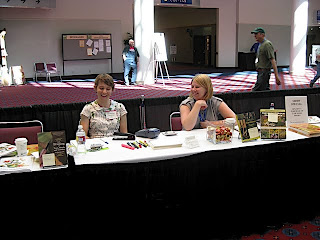

(In real life, our sign did not reflect that much glare. Yet another example of life not imitating art.)
During a slow period Saturday afternoon, Kathryn and I went into the show to check it out. We found a random wind turbine, and Kathryn stood next to it for scale.

Then benches were decorated with facts. I was given an odd look for taking a picture of a bench. I persevered.

There was a central display with new introductions.
Black Eyed Susans

Petunia, "Pretty Much Picasso"

Several of our authors were at the show - Ray Evison, Sean Hogan, and Mike Dirr all made appearances at our booth. Ray also modeled (with a big smile!) his new clematis varieties.

There were lovely displays of trees and grasses from Woodburn Nursery, A&R Spada Farms, and Bizon Nursery.



Plug Connection had a gorgeous living wall display. I think it says "tessera", which means "an individual tile in a mosaic." That seems appropriate, given that the whole things was made up of small succulent plugs. It was gorgeous. I want one at home. I would just sit around and look at it all day long.

Burpee was there with a big edibles display. After the show, when we were all breaking down our booths, they gave away pots and pots and pots of basil.

The car smelled like basil all the way home.
Chani West-Foyle, Marketing Associate
We spent most of our time at our booth, ringing up purchases and testing our knowledge of our books.
(In real life, our sign did not reflect that much glare. Yet another example of life not imitating art.)
During a slow period Saturday afternoon, Kathryn and I went into the show to check it out. We found a random wind turbine, and Kathryn stood next to it for scale.
Then benches were decorated with facts. I was given an odd look for taking a picture of a bench. I persevered.
There was a central display with new introductions.
Black Eyed Susans
Petunia, "Pretty Much Picasso"
Several of our authors were at the show - Ray Evison, Sean Hogan, and Mike Dirr all made appearances at our booth. Ray also modeled (with a big smile!) his new clematis varieties.
There were lovely displays of trees and grasses from Woodburn Nursery, A&R Spada Farms, and Bizon Nursery.
Plug Connection had a gorgeous living wall display. I think it says "tessera", which means "an individual tile in a mosaic." That seems appropriate, given that the whole things was made up of small succulent plugs. It was gorgeous. I want one at home. I would just sit around and look at it all day long.
Burpee was there with a big edibles display. After the show, when we were all breaking down our booths, they gave away pots and pots and pots of basil.
The car smelled like basil all the way home.
Chani West-Foyle, Marketing Associate
Labels:
Authors,
Pacific Northwest,
Shows
Tuesday, August 25, 2009
Double Trouble Chocolate Truffle
Last night I made the Double Trouble Chocolate Truffle recipe from The Complete Chile Pepper Book.
It started easy--I had all the ingredients on hand.

The instructions were pretty easy to follow. First I put the milk and dark chocolate in a small pot.

Then I placed the pot inside of a larger pot full of boiling water. I mixed in the sugar, chile pepper, cinnamon, and condensed milk until it was smooth.

The recipe then said: “Let cool until it’s shapeable.” Hmm. I had never had to let chocolate cool before, so I didn’t understand that it took quite a while. Three hours in fact! So, make sure you start making these a lot earlier than 8 pm.
After they cooled, I shaped them into small balls (and ovals, and some other random shapes unintentionally) and rolled them through chopped pecans.
And they looked like this.

And, we looked like this eating them.

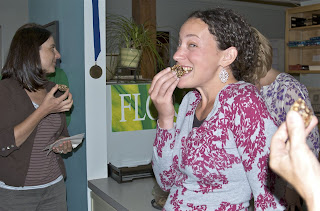

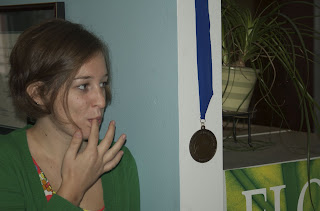

Kathryn Juergens, sales and marketing associate
Recipe from The Complete Chile Pepper Book
It started easy--I had all the ingredients on hand.

The instructions were pretty easy to follow. First I put the milk and dark chocolate in a small pot.

Then I placed the pot inside of a larger pot full of boiling water. I mixed in the sugar, chile pepper, cinnamon, and condensed milk until it was smooth.

The recipe then said: “Let cool until it’s shapeable.” Hmm. I had never had to let chocolate cool before, so I didn’t understand that it took quite a while. Three hours in fact! So, make sure you start making these a lot earlier than 8 pm.
After they cooled, I shaped them into small balls (and ovals, and some other random shapes unintentionally) and rolled them through chopped pecans.
And they looked like this.

And, we looked like this eating them.
Kathryn Juergens, sales and marketing associate
Recipe from The Complete Chile Pepper Book
Friday, August 21, 2009
The Hidden Perils of Peppers?

I was reading through The Complete Chile Pepper Book and came across this useful warning:
Capsaicin, the alkaloid responsible for the heat in chiles, is wonderful for making bland foods interesting, but it is far less welcome in large doses on the skin, or in any amount in your eyes. We urge everyone to who processes chiles in any form to wear gloves when handling them. This is especially important when handling the hotter varieties, because chile burns can be extremely painful and even cause contact dermatitis, redness, and blistering of the skin.
It made me think of the funny segment Jeff Gillman had on The Martha Stewart Show earlier this year. You can watch Martha's laughter-inducing warning here.
Here's another bit from The Complete Chile Pepper Book about what to do if you burn your mouth with a pepper:
When you burn your mouth and tongue, eat a thick dairy product like cream, sour cream, yogurt, or ice cream and swirl it around in your mouth before swallowing. A protein in the dairy product, casein, effectively strips the capsaicin molecules from the capsaicin receptors in your mouth and on your tongue.
After taking in all the above warnings, I think I can safely tackle making this recipe from the book without hurting myself.
Double Trouble Chocolate Truffles
New Mexican red chile is the heat source in this tremendous treat. With the combination of baking chocolate and white chocolate, it’s exceptionally wonderful to munch on. Try substituting 2 teaspoons of cayenne powder for the New Mexican chile to heat the truffles up even more!
Ingredients:
8 ounces baking chocolate
4 ounces white chocolate chips
2 tablespoons sugar (or more to taste)
1 tablespoon ground New Mexican red chile (or more, to taste)
½ teaspoon ground cinnamon
1 14-ounce can light sweetened condensed milk
Finely chopped piñon nuts, or substitute pecans
Directions:
Use a double boiler, or fill a 3-quart saucepan three-quarters full of water, and heat until the water is almost boiling.
Place both kinds of chocolate in a smaller saucepan and melt over the hot water, stirring until smooth.
Add the sugar, chile, cinnamon, and milk, mixing until very smooth. Remove the mixture from the heat and let cool until it is shapeable.
Shape the chocolate mixture into 1-inch thick balls, then roll them in the nuts. Chill the candy in the refrigerator in an airtight tin.
Kathryn Juergens, sales and marketing associate
information and recipe from The Complete Chile Pepper Book, available in October
Labels:
Food,
Garden Remedies,
How-To
Thursday, August 20, 2009
Pacific Golden Chanterelle
The Pacific Golden Chanterelle, or Cantharellus formosus if you’d prefer, is one of the most commonly foraged mushrooms. They are easy to find in the moister parts of Pacific Northwest and in season from early summer until late fall. If you are planning a weekend foraging trip, find a few to make this recipe.
Mushroom Cream Sauce
1 teaspoon olive oil
3 tablespoons butter
3 cloves garlic, minced
1 shallot, diced
2 pounds chanterelles (or morels in early spring), roughly chopped
1 cup cream
Sea salt
Freshly ground black pepper
Crushed red pepper flakes
1. Heat a nonreactive pan over medium heat. Add olive oil and butter. When butter is melted, add garlic and shallots and cook until soft.
2. Add mushroom and sprinkle with salt. Stir and sauté until mushrooms are well cooked.
3. Add enough cream to cover mushrooms halfway (add more if necessary). Stir and cook until sauce is thickened.
4. Add salt and peppers to taste. Pour sauce over pasta, rice, polenta or potatoes, or just enjoy it with bread.
Kathryn Juergens, sales and marketing associate
Images from Mushrooms of the Pacific Northwest
Recipe from Northwest Vegetarian Cooking, available May 2010
Labels:
Edibles,
Food,
Pacific Northwest,
Summer
Monday, August 17, 2009
Universal Plant Achievement of All Time!
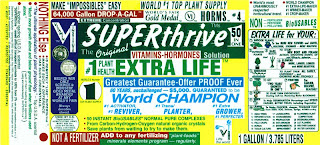
I have to confess I’m obsessed with Horms™ #4 SUPERthrive 50-in-one. If you’ve ever seen a bottle or ad for this amazing product you’ve never forgotten it. We all see plenty of ads in a given day--“Number 1” “Recommended by four out of five dentists”, etc.--but SUPERthrive beats them all. The ads scream the most amazing claims:
“World’s # 1 Top Plant Supply”
“World Champion”
“Best Stuff or Product in the World.”
I absolutely love these outrageous claims, and I tried the product in the first place because they’ve made such an impression. What is SUPERthrive? It’s a mix of 50 vitamins and hormones you add to your watering can, purportedly decreasing plant stress and increasing survivability of transplants. Any self-respecting academic horticulturist will tell you there is no proof that plants can even metabolize vitamins. My skeptical friend and Timber author Sean Hogan scoffs that SUPERthrive only seems to work because you have to start watering your plants to use it. Nonetheless, most people I know who have tried it swear by it--even as they giggle nervously about the ads. So, do I sound like a hick if I admit I go right for the SUPERthrive bottle when one of my plants looks yellowed or stressed out? I can honestly say I’ve never lost a plant when I’ve used it. You heard me right. I’ve never once used SUPERthrive on a sick plant and didn’t see it recover. Maybe the SUPERthrive ads are the only ones that are really telling the truth. It’s something to think about.
Neal Maillet, publisher
Labels:
Garden Remedies
Friday, August 14, 2009
Other People's Gardens
Before I graduated from college, I had a bountiful list formulating in my head of all the things I wanted to do with my life. Things like, travel the world and write an award-winning memoir! Become the next J. K. Rowling! Get an MFA in creative writing! Oddly enough, Live at Home in My Parents Basement was never added to my list of aspirations.
But here I am doing exactly that. My diploma is a year and a half behind me, my school loans are doing a frantic dance in front of my eyes, and yet my junior-high school ivy wallpaper is still singing me to sleep at night. It is not exactly delightful.
On the other hand, there are some perks that come with living at home, one of them being the fact that my mother is a fantastic gardener. She plants delicious vegetables, grows roses and so many other flowers that I couldn’t begin to name them, keeps the grass green, and makes our house look far more amazing than any other house on the street.

Sometimes neighbors stop by our driveway just to say, “Thank you for the beautiful work you do.”
But my favorite part of our garden is the swing. Tucked away under the filbert tree, the swing hangs in a shady, cobweb-ridden, hidden corner of the backyard. Hummingbirds vibrate their way in and out in a few short seconds, squirrels talk to each other from up above and drop discarded nut shells at my feet. A neighbor’s cat lies a few feet away in the shade of the blueberry bushes, watching me.

I do not garden. I’ll admit it. My one attempt at growing wildflowers in a pot failed miserably. But I love, love, love other people’s gardens. I could sit in them all day. And I do.
There is a healing power contained in the swing in my mother’s garden. It comes from the things I can see and hear from that spot; the quiet spiders resting in their patched webs, the way the sun shines on the white roses growing in a perfect circle of brick, even the haphazard growth of the raspberry bushes drooping with berries. The fact that no one can see me back there, staring off into space or writing in a notebook, being healed.

I might not belong forever in my parent’s basement or my childhood bedroom, but I belong in that swing. I belong in someone’s garden. Hopefully it will be my own someday. When my loans are paid……
Jessica Porter, publicity intern
But here I am doing exactly that. My diploma is a year and a half behind me, my school loans are doing a frantic dance in front of my eyes, and yet my junior-high school ivy wallpaper is still singing me to sleep at night. It is not exactly delightful.
On the other hand, there are some perks that come with living at home, one of them being the fact that my mother is a fantastic gardener. She plants delicious vegetables, grows roses and so many other flowers that I couldn’t begin to name them, keeps the grass green, and makes our house look far more amazing than any other house on the street.
Sometimes neighbors stop by our driveway just to say, “Thank you for the beautiful work you do.”
But my favorite part of our garden is the swing. Tucked away under the filbert tree, the swing hangs in a shady, cobweb-ridden, hidden corner of the backyard. Hummingbirds vibrate their way in and out in a few short seconds, squirrels talk to each other from up above and drop discarded nut shells at my feet. A neighbor’s cat lies a few feet away in the shade of the blueberry bushes, watching me.
I do not garden. I’ll admit it. My one attempt at growing wildflowers in a pot failed miserably. But I love, love, love other people’s gardens. I could sit in them all day. And I do.
There is a healing power contained in the swing in my mother’s garden. It comes from the things I can see and hear from that spot; the quiet spiders resting in their patched webs, the way the sun shines on the white roses growing in a perfect circle of brick, even the haphazard growth of the raspberry bushes drooping with berries. The fact that no one can see me back there, staring off into space or writing in a notebook, being healed.
I might not belong forever in my parent’s basement or my childhood bedroom, but I belong in that swing. I belong in someone’s garden. Hopefully it will be my own someday. When my loans are paid……
Jessica Porter, publicity intern
Labels:
Gardening
Thursday, August 13, 2009
DIY Landscape
When my roommates moved into their house about three years ago, their backyard had a depressing, abandoned lot feel to it:
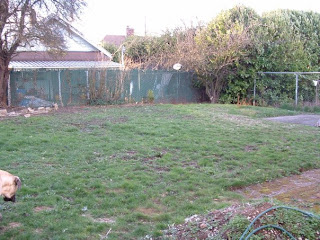
Over the last few years they have already made a ton of improvements, but this summer they decided the time had come for the major DIY landscape. Plants are a little bit like crack to them, so they knew if they got started that this was going to be a full-on binge! They picked a weekend when there was a big plant sale, borrowed a truck from a friend, rented a tiller for the day, and went to town.
I can't really take credit for helping much with this project (besides moral support)...

But they didn't need me!


Since the area right in front of the back door had turned into a major mud pit (and with two big dogs, that gets really old during our eight months of precipitation), they decided to put down a hardscape groundcover of gravel over about a third of the backyard space. And since there was a natural slope to the yard, they used a big island to separate the two levels. They rolled out the insanely carpet-like sod in the upper level of the yard, and they started planting--trees, succulents, ornamental grasses, and lots and lots of pretty flowers!
Even though there is a lot more going on in the "after" pictures, the different levels and zones of the yard actually work to make it feel larger. I am beyond impressed with the results of their handiwork to make our own personal backyard oasis.



A few weeks later, they balanced out the ornamental overload with a veggie bed built from recycled materials from the Rebuilding Center.

Shortly thereafter, Drew really personified Vegetable Love with a fresh harvest from the garden.

Mollie Firestone, editorial assistant

Over the last few years they have already made a ton of improvements, but this summer they decided the time had come for the major DIY landscape. Plants are a little bit like crack to them, so they knew if they got started that this was going to be a full-on binge! They picked a weekend when there was a big plant sale, borrowed a truck from a friend, rented a tiller for the day, and went to town.
I can't really take credit for helping much with this project (besides moral support)...

But they didn't need me!


Since the area right in front of the back door had turned into a major mud pit (and with two big dogs, that gets really old during our eight months of precipitation), they decided to put down a hardscape groundcover of gravel over about a third of the backyard space. And since there was a natural slope to the yard, they used a big island to separate the two levels. They rolled out the insanely carpet-like sod in the upper level of the yard, and they started planting--trees, succulents, ornamental grasses, and lots and lots of pretty flowers!
Even though there is a lot more going on in the "after" pictures, the different levels and zones of the yard actually work to make it feel larger. I am beyond impressed with the results of their handiwork to make our own personal backyard oasis.



A few weeks later, they balanced out the ornamental overload with a veggie bed built from recycled materials from the Rebuilding Center.

Shortly thereafter, Drew really personified Vegetable Love with a fresh harvest from the garden.

Mollie Firestone, editorial assistant
Subscribe to:
Posts (Atom)

